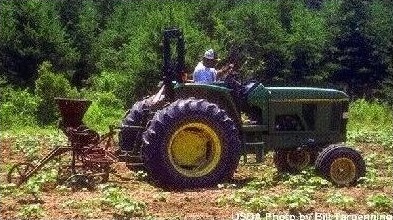Characterization of the Ashepoo-Combahee-Edisto (ACE) Basin, South Carolina
Agriculture

Agriculture has been an important part of the historical, cultural, and economic heritage in the ACE Basin. Its importance to the area dates back to the 1600s when rice, indigo, and cotton were the principal crops. Historic rice production was one of the most influential factors in shaping the colonial economy and, through the creation of impoundments, the present physical condition of the ACE Basin. Agricultural lands occur throughout the ACE Basin study area with high concentrations of croplands on Edisto Island, and areas northwest of Walterboro and southeast of Yemassee. The primary crops presently grown in the ACE Basin are soybeans, wheat, corn, and hay. In recent years, commodity prices have declined and farmers in the ACE Basin are attempting to diversify. One means of diversification is truck farming. Currently, the largest truck crop is watermelons, with other vegetables such as cabbage, collards, squash, cantaloupe, and strawberries being cultivated.
In Colleton County, farming directly contributed $15.8 million in cash to the local economy in 1996, with 75% resulting from crops and the remainder from livestock. Twelve percent of the land in the ACE Basin study area has been developed for agricultural production; however, the amount of land farmed in counties within and surrounding the ACE Basin study area has declined since 1978. The number of farms has declined at an average annual rate of 1.2% during the period from 1982 to 1996. This is greater than the statewide decline of 0.98% over the same time period. Despite this decline, agricultural practices in 1996 accounted for over $15 million in revenue for Colleton County alone. Urbanization is probably a leading cause of the reduction of farmlands in South Carolina. High land prices, which exceed $950 an acre in Colleton County, mean that farmers often profit more from selling the land than from farming the land.
Agriculture can have numerous impacts on the environment. Activities such as land clearing, irrigation, impounding of wetlands, ditching, and soil cultivation have markedly altered the landscape of the ACE Basin. Agricultural effects on water quality have also had a noteworthy impact. Conservation measures have been developed to help the farmer minimize agricultural nonpoint source pollution and other impacts. The most common agricultural conservation measures used in Colleton County are crop rotation, integrated pest management, weed management, runoff management, nutrient management, and pasture management.
In order for agriculture to continue as a viable practice in the ACE Basin, prime agricultural land must be protected as a valuable natural resource, farming practices must be improved and agriculturally-based businesses enhanced (Beasley et al. 1996). The agricultural landscape adds to the quality of life by providing open space to balance that of urban areas in the ACE Basin study area and contributes in the long-term to the economic, social, and ecological fabric of the area.
